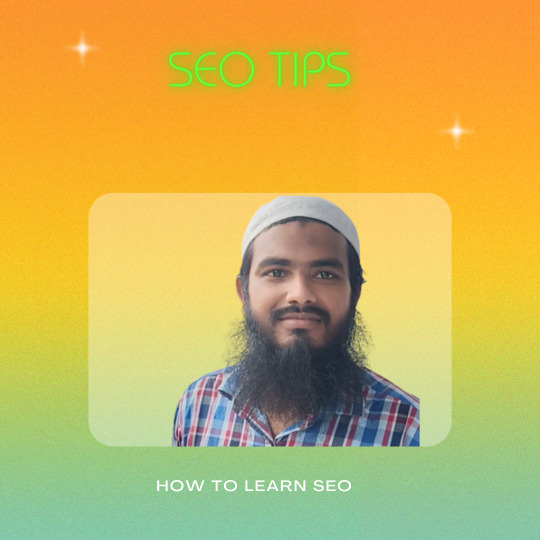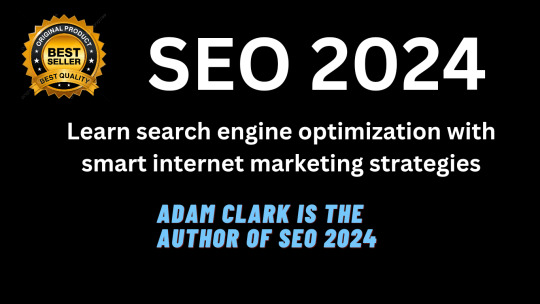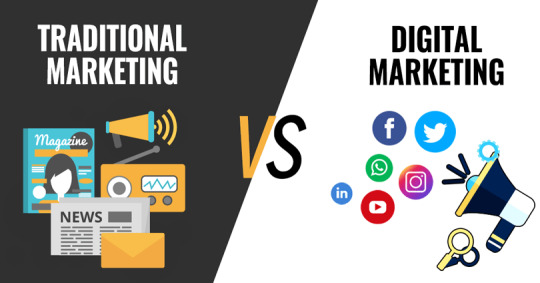#how to learn SEO
Explore tagged Tumblr posts
Text
How To Learn SEO By Yourself

Learning SEO (Search Engine Optimization) is a valuable skill that can help improve the visibility and ranking of websites in search engine results. Here's a step-by-step guide on how to learn SEO:
Understand the Basics: Start by getting familiar with the fundamental concepts of SEO, including keywords, on-page and off-page optimization, link building, and search engine algorithms. You can find introductory articles and guides on reputable websites like Moz, HubSpot, and Search Engine Land.
Quality Online Resources: Explore reliable online resources dedicated to SEO. Some of the best include:
Moz: Offers a comprehensive beginner's guide to SEO.
Ahrefs: Provides in-depth SEO tutorials and case studies.
Google's Search Engine Optimization (SEO) Starter Guide: An official guide from Google.
Backlinko: Brian Dean's blog with practical SEO insights.
Online Courses: Consider enrolling in SEO courses on platforms like:
Coursera
Udemy
HubSpot Academy
Books: Explore SEO books written by industry experts. Some recommended titles include:
"The Art of SEO" by Eric Enge, Stephan Spencer, and Jessie Stricchiola
"SEO 2022" by Adam Clarke
"The Beginner's Guide to SEO" by Moz
Practical Application: Start your own blog or website to practice SEO techniques. Optimize your content, conduct keyword research, and track your website's performance using tools like Google Analytics and Google Search Console.
Stay Updated: SEO is a constantly evolving field. Stay informed about the latest trends, algorithm updates, and best practices by following industry news, blogs, and social media accounts of SEO experts.
Networking: Join SEO communities and forums to connect with other enthusiasts and professionals. Platforms like Reddit's r/SEO and LinkedIn groups can be great for networking.
SEO Tools: Familiarize yourself with essential SEO tools such as keyword research tools (e.g., Google Keyword Planner, SEMrush, Ahrefs), SEO plugins (e.g., Yoast SEO for WordPress), and technical SEO tools (e.g., Screaming Frog SEO Spider).
Patience and Persistence: SEO is a long-term strategy, and results may not be immediate. Be patient, stay persistent, and keep learning and adapting as the landscape changes.
Certifications: Consider pursuing certifications such as Google's Google Analytics Certification and Google Ads Certification, which can enhance your credibility as an SEO professional.
Hands-on Experience: If possible, gain practical experience by working on real SEO projects, either for your own websites or for clients. Practical experience can reinforce your learning and help you understand the nuances of SEO.
Remember that SEO is a dynamic field, so continuous learning and adaptation are essential. As you gain experience and knowledge, you can become proficient in SEO and apply these skills to improve the online visibility of websites and businesses.
2 notes
·
View notes
Text
SEO 2024 By Adam Clark
Rank Your Website At The Top On Google
In this SEO book you will find:
1. SEO explained in simple language, beginner to advanced.
2. The inner workings of Google’s algorithm and how it calculates the search results.
3. How to find “money��� keywords that will send customers to your site.
4. Sneaky tricks to get local businesses ranking high with local SEO.
5. How to get featured in the mainstream news, for free.
6. Three sources to get expert SEO and Internet marketing advice worth thousands of dollars for free.
7. A simple step-by-step checklist and video tutorials, exclusive for readers.
Read More

#SEO 2024#seo2024#learn seo#how to learn seo#rank your website by seo#SEO 2024 Review#seo 2024#SEO 2024 By Adam Clark#How to do seo#Search Engine Oftimaization#make money online#make money online from home#work from home
0 notes
Photo


CHANGBIN in<★★★★★ (5-STAR)> UNVEIL : TRACK 3 죽어보자
#seo changbin#changbin#stray kids#bystay#////#val's gifs#dreamytag#heyale#binkie#this was fun i got to learn how to blur logos#thanks to the youtube tutorial i found#yeehaw
247 notes
·
View notes
Text








seo moonjo in episode 3
#i wish i could watch this show with magnifying glasses or smth#i love the facial expressions in this show#0 reason for this post other than i find his facial expressions very interesting#god shouldn't've let me learn how to make gifs on tumblr#moonjo trying to get jongwoo to talk for the whole conversation is very funny to me#'ok so just talking about crime isn't enough... time to bring up raymond chandler'#strangers from hell#seo moonjo#hell is other people
32 notes
·
View notes
Text
Life's too short to even care at all, whoa-oh-oh I'm losing my mind, losing my mind, losing control...
#jang han seo#kwak dong yeon#vincenzo#this is my first time doing video edit; spent wayyyyy too much on it haha#but it was fun; i had a fun time learning how capcut and after effects worked#this is just something that's been on my mind for way too long and i'm glad i've finally got to make it a reality now#enjoy :3#*mine#*edits
47 notes
·
View notes
Photo










Our Blues (2022) – episode 18
#Our Blues#ourbluesedit#kdramaedit#Kim Woo Bin#Lee Jung Eun#Bae Hyun Sung#Roh Yoon Seo#Choi Young Joon#Park Ji Hwan#Shin Min Ah#Jung Sung Il#Kim Hye Ja#kdrama#all#m:gifs#so glad I found the right psd. it just works the way I edit#(sure I still need to learn how to color better but it works)
75 notes
·
View notes
Text
Alchemy of Souls as Community quotes.






i

(part 2 here)
#i don't even watch community how did this happen#i learned how to take screenshots from netflix for this#incorrect alchemy of souls quotes#alchemy of souls#jang uk#mudeok#cho yeong#my best boy the crown prince#alchemy of souls as community quotes#incorrect quotes#source: community#seo yul#go won#alchemy of souls: light and shadow#ukyeong
50 notes
·
View notes
Text
Must-Have Programmatic SEO Tools for Superior Rankings

Understanding Programmatic SEO
What is programmatic SEO?
Programmatic SEO uses automated tools and scripts to scale SEO efforts. In contrast to traditional SEO, where huge manual efforts were taken, programmatic SEO extracts data and uses automation for content development, on-page SEO element optimization, and large-scale link building. This is especially effective on large websites with thousands of pages, like e-commerce platforms, travel sites, and news portals.
The Power of SEO Automation
The automation within SEO tends to consume less time, with large content levels needing optimization. Using programmatic tools, therefore, makes it easier to analyze vast volumes of data, identify opportunities, and even make changes within the least period of time available. This thus keeps you ahead in the competitive SEO game and helps drive more organic traffic to your site.
Top Programmatic SEO Tools

1. Screaming Frog SEO Spider
The Screaming Frog is a multipurpose tool that crawls websites to identify SEO issues. Amongst the things it does are everything, from broken links to duplication of content and missing metadata to other on-page SEO problems within your website. Screaming Frog shortens a procedure from thousands of hours of manual work to hours of automated work.
Example: It helped an e-commerce giant fix over 10,000 broken links and increase their organic traffic by as much as 20%.
2. Ahrefs
Ahrefs is an all-in-one SEO tool that helps you understand your website performance, backlinks, and keyword research. The site audit shows technical SEO issues, whereas its keyword research and content explorer tools help one locate new content opportunities.
Example: A travel blog that used Ahrefs for sniffing out high-potential keywords and updating its existing content for those keywords grew search visibility by 30%.
3. SEMrush
SEMrush is the next well-known, full-featured SEO tool with a lot of features related to keyword research, site audit, backlink analysis, and competitor analysis. Its position tracking and content optimization tools are very helpful in programmatic SEO.
Example: A news portal leveraged SEMrush to analyze competitor strategies, thus improving their content and hoisting themselves to the first page of rankings significantly.
4. Google Data Studio
Google Data Studio allows users to build interactive dashboards from a professional and visualized perspective regarding SEO data. It is possible to integrate data from different sources like Google Analytics, Google Search Console, and third-party tools while tracking SEO performance in real-time.
Example: Google Data Studio helped a retailer stay up-to-date on all of their SEO KPIs to drive data-driven decisions that led to a 25% organic traffic improvement.
5. Python
Python, in general, is a very powerful programming language with the ability to program almost all SEO work. You can write a script in Python to scrape data, analyze huge datasets, automate content optimization, and much more.
Example: A marketing agency used Python for thousands of product meta-description automations. This saved the manual time of resources and improved search rank.
The How for Programmatic SEO
Step 1: In-Depth Site Analysis
Before diving into programmatic SEO, one has to conduct a full site audit. Such technical SEO issues, together with on-page optimization gaps and opportunities to earn backlinks, can be found with tools like Screaming Frog, Ahrefs, and SEMrush.
Step 2: Identify High-Impact Opportunities
Use the data collected to figure out the biggest bang-for-buck opportunities. Look at those pages with the potential for quite a high volume of traffic, but which are underperforming regarding the keywords focused on and content gaps that can be filled with new or updated content.
Step 3: Content Automation
This is one of the most vital parts of programmatic SEO. Scripts and tools such as the ones programmed in Python for the generation of content come quite in handy for producing significant, plentiful, and high-quality content in a short amount of time. Ensure no duplication of content, relevance, and optimization for all your target keywords.
Example: An e-commerce website generated unique product descriptions for thousands of its products with a Python script, gaining 15% more organic traffic.
Step 4: Optimize on-page elements
Tools like Screaming Frog and Ahrefs can also be leveraged to find loopholes for optimizing the on-page SEO elements. This includes meta titles, meta descriptions, headings, or even adding alt text for images. Make these changes in as effective a manner as possible.
Step 5: Build High-Quality Backlinks
Link building is one of the most vital components of SEO. Tools to be used in this regard include Ahrefs and SEMrush, which help identify opportunities for backlinks and automate outreach campaigns. Begin to acquire high-quality links from authoritative websites.
Example: A SaaS company automated its link-building outreach using SEMrush, landed some wonderful backlinks from industry-leading blogs, and considerably improved its domain authority. ### Step 6: Monitor and Analyze Performance
Regularly track your SEO performance on Google Data Studio. Analyze your data concerning your programmatic efforts and make data-driven decisions on the refinement of your strategy.
See Programmatic SEO in Action
50% Win in Organic Traffic for an E-Commerce Site
Remarkably, an e-commerce electronics website was undergoing an exercise in setting up programmatic SEO for its product pages with Python scripting to enable unique meta descriptions while fixing technical issues with the help of Screaming Frog. Within just six months, the experience had already driven a 50% rise in organic traffic.
A Travel Blog Boosts Search Visibility by 40%
Ahrefs and SEMrush were used to recognize high-potential keywords and optimize the content on their travel blog. By automating updates in content and link-building activities, it was able to set itself up to achieve 40% increased search visibility and more organic visitors.
User Engagement Improvement on a News Portal
A news portal had the option to use Google Data Studio to make some real-time dashboards to monitor their performance in SEO. Backed by insights from real-time dashboards, this helped them optimize the content strategy, leading to increased user engagement and organic traffic.
Challenges and Solutions in Programmatic SEO
Ensuring Content Quality
Quality may take a hit in the automated process of creating content. Therefore, ensure that your automated scripts can produce unique, high-quality, and relevant content. Make sure to review and fine-tune the content generation process periodically.
Handling Huge Amounts of Data
Dealing with huge amounts of data can become overwhelming. Use data visualization tools such as Google Data Studio to create dashboards that are interactive, easy to make sense of, and result in effective decision-making.
Keeping Current With Algorithm Changes
Search engine algorithms are always in a state of flux. Keep current on all the recent updates and calibrate your programmatic SEO strategies accordingly. Get ahead of the learning curve by following industry blogs, attending webinars, and taking part in SEO forums.
Future of Programmatic SEO
The future of programmatic SEO seems promising, as developing sectors in artificial intelligence and machine learning are taking this space to new heights. Developing AI-driven tools would allow much more sophisticated automation of tasks, thus making things easier and faster for marketers to optimize sites as well.
There are already AI-driven content creation tools that can make the content to be written highly relevant and engaging at scale, multiplying the potential of programmatic SEO.
Conclusion
Programmatic SEO is the next step for any digital marketer willing to scale up efforts in the competitive online landscape. The right tools and techniques put you in a position to automate key SEO tasks, thus optimizing your website for more organic traffic. The same goals can be reached more effectively and efficiently if one applies programmatic SEO to an e-commerce site, a travel blog, or even a news portal.
#Programmatic SEO#Programmatic SEO tools#SEO Tools#SEO Automation Tools#AI-Powered SEO Tools#Programmatic Content Generation#SEO Tool Integrations#AI SEO Solutions#Scalable SEO Tools#Content Automation Tools#best programmatic seo tools#programmatic seo tool#what is programmatic seo#how to do programmatic seo#seo programmatic#programmatic seo wordpress#programmatic seo guide#programmatic seo examples#learn programmatic seo#how does programmatic seo work#practical programmatic seo#programmatic seo ai
3 notes
·
View notes
Text
Tomorrow I have a quiz for SEO but it's mostly multiple choice? So yaaay! Finished my assignment for today but fucked up so bad lmao we were supposed to only take an 1hr and I did BUT I DID IT WRONG? It was a whole presentation ;A; I didn't notice "format must be in html" so I had to redo it...guess which bitch can't read! Meeee.
#nimo's sheeko sheeko time#next week its microsoft office lmaooooooo#it's hilarious how strangely ordered this is for me...#started with resumes then with seo and now microsoft applications...#despite using both microsoft applications AND canva for the last two courses#whatever I'm learning a lot so that's good and what truly matters lmao#also so far my average is 90!!! weeeee#hope the second assignment and quiz dont drag that down...#wanna use what grade I get in college for future resumes
2 notes
·
View notes
Text




#i am malfunctioning#you're welcome for doing god's work#yes this man arrest him#learn how to serve from him#racha log#skz#straykids#autumn sighs#seo changbin#dwaekki
14 notes
·
View notes
Text
How can you learn seo?
Learning SEO (Search Engine Optimization) involves a combination of study, practice, and staying updated with industry changes. Here's a structured approach:
Start with Basics: Understand how search engines work, including algorithms and ranking factors.
Study Resources: There are many online tutorials, blogs, and courses available. Websites like Moz, Search Engine Journal, and Neil Patel's blog offer valuable insights. Take Courses: Consider taking online courses from platforms like Coursera, Udemy, or HubSpot Academy, which offer comprehensive SEO courses.
Practice: Apply what you learn by optimizing your own website or blog. Experiment with different techniques and analyze the results.
Stay Updated: SEO is constantly evolving, so subscribe to industry newsletters, follow SEO experts on social media, and attend webinars or conferences.
2 notes
·
View notes
Text
im still too busy with school, work, and trying to find a place to live that lets me cut down my 1 hour one-way commute to work to think about rp but let it be known every day i think 'wow i used to have free time'
#now im having to write essays on (checks) compensation and benefits packages for CEOs#and how to help an employee file grievances with a supervisor#while also learning about SEOs and SMM for social media bcuz i love having too much crammed into my brain
4 notes
·
View notes
Text
#Seo#seo course#seo training#Neil patel#free seo course#free seo training#learn set#how to do set#Neil patel set
3 notes
·
View notes
Text


Binnie ehehe ✨️
#we're learning how to draw noses lads#ANYWAYS binnie ehehe#my art hhhh#stray kids#skz#seo changbin#changbin#stray kids changbin#skz changbin#staytistontumblr
10 notes
·
View notes
Text
Become a Digital Marketing Pro: Learn the Basics NOW!
What is Digital Marketing?
Digital Marketing refers to the marketing of products and services of a company or business through digital channels such as search engines, websites, email, social media, mobile apps, etc. It involves the use of electronic devices and the internet. Digital marketing is often referred to as online marketing, internet marketing or web marketing.
Digital marketing mainly comprises Search Engine Optimization (SEO), Social Media Optimization (SMO), and Search Engine Marketing (SEM). We can say that it can be divided into three parts SEO, SMO, and SEM. However, Email Marketing and Affiliate Marketing have also become important components of digital marketing over the past few years. So, in digital marketing, we mainly deal with the following components:
SEO
SMO
SEM
Email Marketing
Affiliate Marketing

Why choose Digital Marketing?
Non-Digital Marketing, which is the traditional means of marketing, includes the usage of physical means of marketing. These are generally in the form of physical prints such as posters, flyers, newspaper advertisements, and billboards. Even at the first glance, it is quite apparent why almost every business is choosing to get into Digital Marketing.
The primary and the most fundamental reasoning for this is the amount of reach that is possible with it. There are smart devices everywhere, from televisions, laptops, computers, and tablets to smartphones. Even cars have smart systems enabled in them where you can access the Internet. All of these facilities present a blank canvas for advertising your brand.

How does Digital Marketing work?
There are two ways in which Digital Marketing is implemented by brands and businesses:
B2C (Business to Customer)
B2B (Business to Business)
B2C (Business to Customer):
When a brand or a company has to sell a product or service to individual customers. In fact, 95 percent of the time, the ads and marketing that you see online are examples of B2C campaigns, e.g., an ad for a candy bar, a promotional video for a safety razor, or a movie trailer. All of these marketing efforts are targeting individual consumers and not organizations.
B2B (Business to Business):
B2B is conducted for very specific products. You wouldn’t generally see B2B products being advertised on platforms with traffic from the everyday crowd. These marketing campaigns are low profile, professional, and in most cases, marketed directly (or pitched) to the client. This client can be a small business or a corporate giant. We can take heavy-duty cooking machinery used in big fast-food restaurants as an example. What would be the point of running a TV ad for an industry-level chimney? None. This sort of marketing is done through B2B-specialized salesmen who use custom-made marketing material, PowerPoint presentations, and word of mouth to pitch their product.

Not surprisingly, billions of marketing dollars spent on traditional channels is already starting to shift to digital marketing campaigns and this will continue to increase as the Web matures.
#digital marketing#digital marketing from basics#Introduction to digital marketing#how to learn digital marketing#what is digital marketing#online marketing#affiliate marketing#Basics of digital marketing#Why choose digital marketing#How does digital marketing work#learn digital marketing#Email marketing#search engine optimisation#seo#seo marketing
13 notes
·
View notes
Text

What Is Local SEO and Why Is It So Important?
Local SEO helps your business stand out – even if you don’t have a website – and helps drive more traffic to your premises through online leads.
Since these leads are from people who are specifically searching for products or services that your business offers, they are also likely to give you a high conversion rate.
Searches with local intent are on the rise – with 4 in 5 consumers now using search engines to find local information, and search result information sending a massive 70% of consumers to a physical store.
Local SEO also helps drive people’s decisions in favor of your business. The more information they have about your business before they visit, the more trustworthy you are in their eyes.
get seo expert online Now
#seo#what is seo#seo for beginners#seo course#seo basics#seo tips#learn seo#seo 2022#seo full course#seo 2023#seo tools#how to do seo#seo training#what is seo and how does it work#how seo works#seo tips 2022#seo trends 2023#youtube seo#seo in hindi#seo strategy#what is seo marketing#seo教学#seo explained#seo tools 2022#seo marketing#instagram seo#full seo course#free seo course#seo news
4 notes
·
View notes